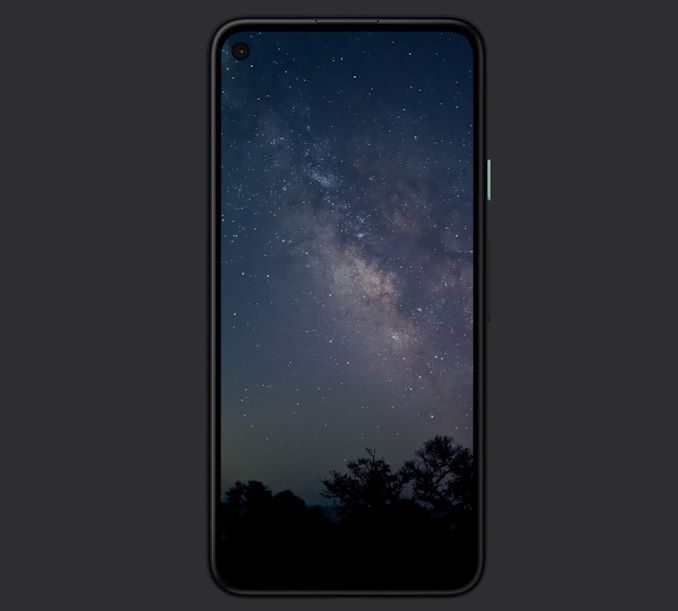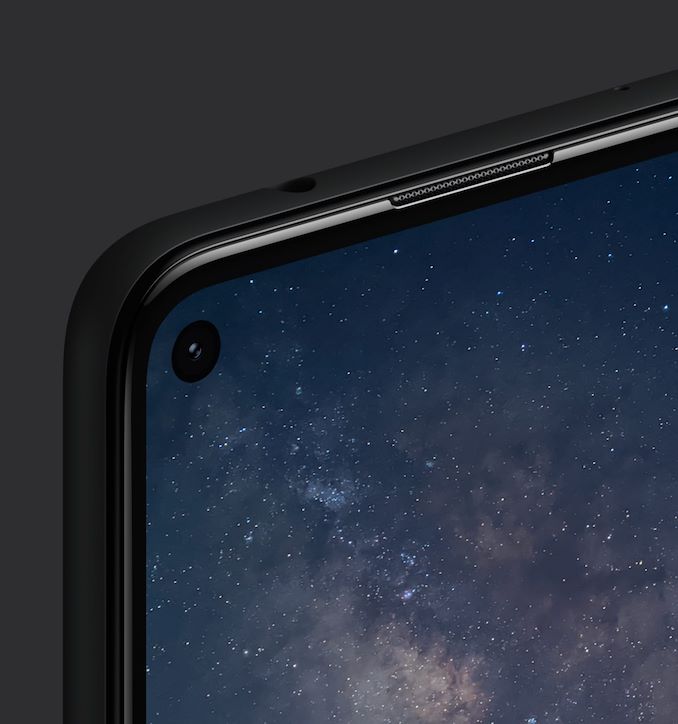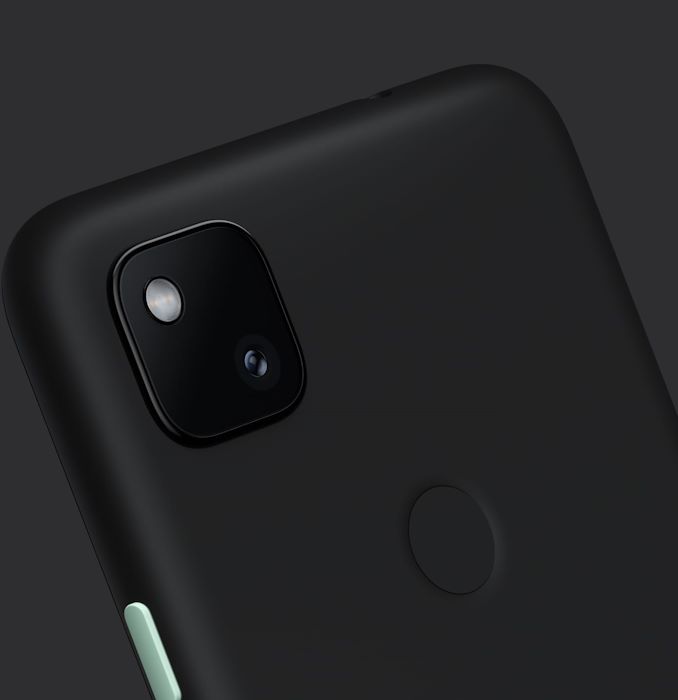Google Announces Pixel 4a - A $349 Value
by Andrei Frumusanu on August 3, 2020 11:30 AM EST- Posted in
- Mobile
- Smartphones
- Pixel 4a

Today Google is announcing its 2020 successor to its budget/mid-range line of phones in the form of the new Pixel 4a. Awaited since several months now, but seemingly delayed into August, the new Pixel 4a brings to the table a few key upgrades whilst offering a Google software experience at a $349 price point.
Last year’s Pixel 3a and Pixel 3a XL were seemingly well received devices, with Google’s strategy being mostly focused on offering a “Google Experience” software stack that’s only found on Pixel devices. This year, Google is trying to continue this focus with the Pixel 4a, with the biggest obvious change being that we’re not seeing a 4a XL being released at this point in time.
| Google Pixel 4a | ||
| Pixel 4a | ||
| SoC | Snapdragon 730G 2x Kryo 470 (CA76) @ 2.2GHz 6x Kryo 470 (CA55) @ 1.8GHz Adreno 618 |
|
| DRAM | 6GB LPDDR4X | |
| Display | 5.81" OLED 2340 x 1080 (19.5:9) |
|
| Size | Height | 144.0 mm |
| Width | 69.4 mm | |
| Depth | 8.2 mm | |
| Weight | 143 grams | |
| Battery Capacity | 3140mAh | |
| Wireless Charging | - | |
| Rear Cameras | ||
| Main | 12.2MP 1.4µm Dual Pixel PDAF f/1.7 77° lens with OIS |
|
| Telephoto | - | |
| Wide | - | |
| Extra | - | |
| Front Camera | 8MP 1.12µm f/2.0 84° lens; fixed focus |
|
| Storage | 128GB UFS 2.1 | |
| I/O | USB-C 3.5mm headphone jack |
|
| Wireless (local) | 802.11ac Wave 2 Wi-Fi Bluetooth 5.1 LE + NFC |
|
| Cellular | Snapdragon X15 LTE (Category 12/5) DL = 600Mbps 3x20MHz CA, 256-QAM UL = 150Mbps 2x20MHz CA, 64-QAM |
|
| Other Features | Dual Speakers, 18W Fast Charging | |
| Dual-SIM | 1x nanoSIM + eSIM | |
| Launch Price | $349 / 349£ / 349€ | |
Hardware-wise, the Pixel 4a is being powered by the Qualcomm Snapdragon 730G SoC, a chip platform that’s nearly 1.5 years old by now. The SoC features two Cortex-A76 cores at 2.2GHz and six Cortex-A55 cores at 1.8GHz, accompanied by an Adreno 618 GPU.
Whilst certainly not a bad SoC in itself and is well fitting for a device of this price range, the fact that Google had opted to release a 4G device at this point in time, and versus new the competition such as 399€ Snapdragon 765 phones like the OnePlus Nord puts the Pixel 4a at a rough spot in terms of long-term value proposition. We’re currently at an inflection point between standards in the smartphone industry, so it’s definitely something I would consider if you’re planning to keep a device for more than a year.
Memory wise, Google has configured the Pixel 4a competitively as it features 6GB of RAM and 128GB of storage.
One of the best aspects of the Pixel 3a phones were that they feature OLED displays, and the 4a continues the trend for the higher-quality display technology even though the phones are at the lower price range. The screen diagonal has risen to 5.81”, however that’s only because the aspect ratio has been increased to 19.5:9 thanks to the move to a full-screen display design.
The 2340 x 1080 resolution screen now features a hole-punch front-camera located in the left corner of the notification area, actually representing Google’s most modern design aesthetic to date in this regard.
The phone has a similar form-factor as the Pixel 3a, actually shrinking in length from 151.3 to 144mm. The width which most notably is the defining factor into one-hand usability of a phone has remained similar at 69.4mm – which is actually on the smaller size compared to most other devices on the market right now.
The small size does have one disadvantage, and that’s the battery size which falls in at 3140mAh which isn’t all that competitive in the current landscape. The only silver lining here is that the phone weighs in at only 143g which makes it very lightweight, a lot having to do with the plastic housing of the phone that is actually quite uncommon to find in a phone nowadays.
The phone features up to 18W PD charging capability, however wireless charging was one of the features on the chopping block in order to achieve the lower price-point.
In terms of camera experience, it’s pretty straightforward for the Pixel 4a: It houses the very same module that is found on the Pixel 4. This means it’s again the same 12.2MP sensor coupled with a f/1.7 optical system at a conventional viewing angle of 77° which corresponds to a 27mm equivalent focal length.
The good news for the Pixel 4a is that at this price range, the phone should have an easy time to compete with most other phones as the camera is still amongst the best performers on the market. Whilst the main module is seemingly going to offer a great experience and will certainly be able to compete and probably outperforms phones such as the iPhone SE, it’s still only a single camera module setup – which is going to be again quite weird given that most other vendors at least have two usable camera modules, most of them opting for an ultra-wide-angle.
The front-camera also sees the adoption of the very same 8MP f/2.0 module that is found on the Pixel 4.
In essence, the camera performance of the Pixel 4a should be in line with the Pixel 4, for which you can read our comprehensive comparison in context of all other flagship devices in 2020.
Other notable mentions of the Pixel 4a is the fact that it continues to use a rear capacitive fingerprint reader, and luckily still maintains a 3.5mm headphone jack that’s no longer present on the higher-end Pixel phones.
A Lower Price at $349
The Pixel 4a comes at $349 which is $50 less than the launch price of the Pixel 3a last year. What we’re getting this year are a more notably updated processor, more RAM, double the default storage which has been upgraded to UFS 2.1, and a new design including a new screen with longer aspect ratio. Whilst the camera department has seen the adoption of the new modules from the Pixel 4, these weren’t that big of a jump over the Pixel 3 and 3a – and Google still keeps things very simplistic with only a single rear camera.
Overall, it feels like it’s a solid package, at least it feels a quite better value proposition than what the Pixel 3a was last year. However, Google’s only real strength here is the camera processing; a $50 more expensive OnePlus Nord offers a faster SoC with future-proof 5G connectivity, a 90Hz screen, and throws in the extra ultra-wide-angle camera, even though it’s possibly not great in quality.
It should be noted that the Pixel 4a has a petite stature, and the lack of a Pixel 4a XL means that if you’re looking for a small phone, the 4a is amongst only a few other rare offerings on the market right now.
I see Google having a tough time against the mid-range competition in global markets, the fact that there’s almost no other comparable device offering in the US makes the Pixel 4a a seemingly no-brainer choice at this price segment, with the phone offering a magnitude better value than the flagship Pixel 4 line-up.
Availability for the Pixel 4a starts August 20th in the US, with later release dates in other markets such as October 1st for the UK, and late-to-mid September for other European markets.
Google also made a teaser mention that we’ll be seeing a 5G variant of the Pixel 4a later this year at a price point of $499, which if the only upgrades are a 5G compatible SoC, will be quite uncompetitive in pricing.
Related Reading:
- Google Teases Pixel 4a (5G) and Pixel 5 Later This Year
- The Google Pixel 4 XL Review: Stuck In The Past In 2019
- The Google Pixel 3a XL Review: Does Mid-Range Make Sense?
- Mobile Flagship Phone Camera Overview 2020 H1: Still Picture Battle
- Google Announces Pixel 3a & Pixel 3a XL: Mid-Range Phones With Flagship Camera
- The Google Pixel 3 Review: The Ultimate Camera Test
- OnePlus Announces Nord - Snapdragon 765 at 399€













153 Comments
View All Comments
Alistair - Monday, August 3, 2020 - link
The S9 will be fine for years.Peskarik - Tuesday, August 4, 2020 - link
Samsung camera is asia-fied in terms of processing, makes your face/skin looks smoother and yellower/brighter. Same goes for many other phones, but not for Google, they keep to the reality of things, and I like that, I do not want to look like a doll.ichaya - Tuesday, August 4, 2020 - link
Android updates do have plenty of useful new features. Switching to Lineage if you're so inclined is definitely a plus on S9, but for those who can't get Lineage and still want security+bugfix updates and full OS updates, it's more than worth it to stick to Pixel phones that have the best Android update cycles.Retycint - Tuesday, August 4, 2020 - link
Name me a few features from Android 10 that you use regularly? Because I honestly can't. I have an S8+ running on a custom Android 10 ROM as well as an older backup phone running Android 6, and have no issues using both. They are functionally identical to me, given my usage scenario of web browsing, social media, light gaming etc.And I imagine this to be the case for many consumers as well. Updates just don't matter in the current day, where Android is already super polished and feature rich out of the box
ichaya - Tuesday, August 4, 2020 - link
If nobody cared about Android updates, I'd still be using my Nexus 5. Updates definitely matter, how much is debatable, though not really if talking about a 3+ year period. Getting Lineage is a great way to get updates since OEMs aren't always up to the task, but not everyone can do this by themselves just because you can. If you're spending $250+ on a phone, getting updates is basically future-proofing to the average person. I think most people have figured this out by now. I have some Android One phones (Similar cost/specs) from other countries, and they have gotten more updates than Moto phones in the US!I have regularly used most of these features, other than maybe gestures: https://www.android.com/android-10/ and I would definitely notice some of the little things and privacy features if they were missing.
ichaya - Tuesday, August 4, 2020 - link
* I do use my Nexus 5 as a backup, though perhaps I'd still be using my Nexus 4 too if I didn't care about updates and it's battery wasn't out.teldar - Tuesday, August 4, 2020 - link
So your Samsung software is so great, you had to replace its operating system? And you're running Android 10, but don't see any features you use?Quantumz0d - Tuesday, August 4, 2020 - link
Like Scoped bullshit storage ? or the blocked APIs for basic stuff like Wifiman ? Android is copying Apple more than any company. That idiotic sandboxed filesystem is 100% clone of Apple. They also ruined the multi tasking interface and navigation by copying Apple again.Android apps are the main ones not the garbage OS, Pixel HW is utter trash when it comes to the pure features. It's only the Software but when the Software is also becoming garbage what's the use ? Android apps get udpated on even Android version 5-6-7-8. That's where Google's Android strength comes from but the higher ups at Google are using iPhones everyday and are brainwashed to Apple and want to remove that as well slowly.
The same gets perforated on Android esp with Android 9+ copying damn navigation, multitasking and every single thing to even removing jack / pricing etc. Pixel is a bust in total share in U.S / N.A market. They are less than 5%, that means the Pixel is a sinking ship. Atop the politically correct trash heap at Google this ship is going to sink soon.
Pixel's top brass, like Engineers in Image Processing one guy alr left. Marc Levoy, with Apple catching up to Pricing / SW / Camera this Pixel is going to wrap up, I didn't even mention the utterly horrible QC of the SW & HW, and horrible Custom ROM support with the bs filesystem restrictions by read only etc.
ichaya - Tuesday, August 4, 2020 - link
lol, complaining about Android 'horrible Custom ROM support' when iOS has nothing similar. I get Google/Android app updates all the time, far more often than Android updates. Apple is the company that slowed down phones, has horrible thermal problems in laptops, and couldn't get a keyboard right. Nothing they do is open source, so I'll stick to open source Android thanks.teldar - Tuesday, August 4, 2020 - link
Generally 2, from what I've found. After two years Samsungs are unusable. They slow down to the point they are basically useless and you shouldn't even think about getting software updates from them. I switched from several Galaxy phones, the 3,5, and 7 (and watching my wife with the 4, 7 and 10) to a Pixel 2 XL and couldn't be happier. Android updates? First, Monthly security and bug fixes, one of the best cameras in a smart phone, the best personal assistant baked in and integrated, the ability to change my launcher, and last, but not least, great performance even 2 1/2 years after I bought the phone. I'm very happy with my Pixel and glad I left Samsung.